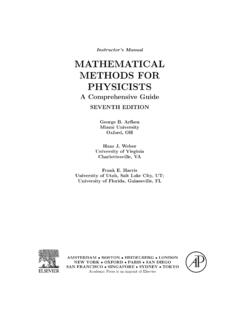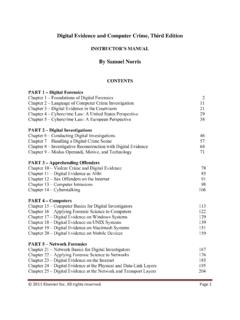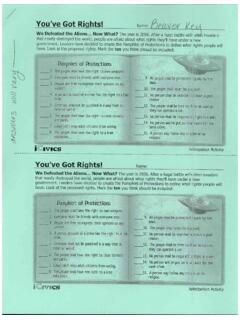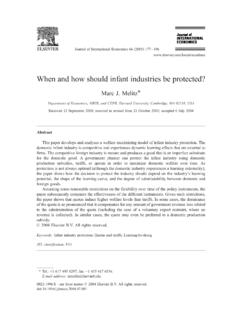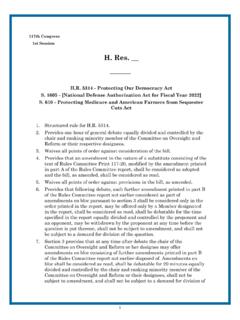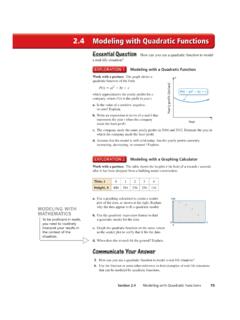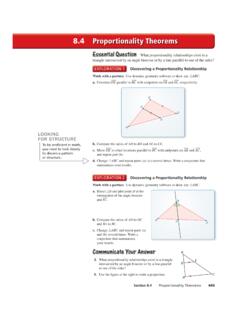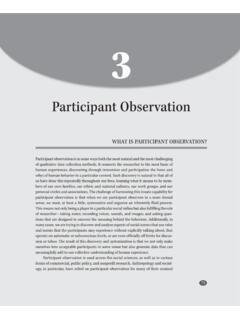Transcription of Computer Networks: A Systems Approach Fifth Edition ...
1 Computer Networks: A Systems ApproachFifth EditionSolutions ManualLarry Peterson and Bruce Davie20111 Dear Instructor:ThisInstructors Manualcontains solutions to most of the exercises in the Fifth editionof Peterson and Davie sComputer Networks: A Systems are sorted (roughly) by section, not difficulty. While some exercises aremore difficult than others, none are intended to be fiendishlytricky. A few exercises(notably, though not exclusively, the ones that involve calculating simple probabilities)require a modest amount of mathematical background; most donot. There is a sidebarsummarizing much of the applicable basic probability theory in Chapter occasional exercise is awkwardly or ambiguously worded in the text. This manualsometimes suggests better versions; also see the errata at the web appropriate, relevant supplemental files for these solutions ( ) havebeen placed on the textbook web site, other material can also be found there, such as errata, sample programmingassignments, PowerPoint lecture slides, and EPS you have any questions about these support materials, please contact your MorganKaufmann sales representative.
2 If you would like to contribute your own teachingmaterials to this site, please contact our Associate EditorDavid welcome bug reports and suggestions as to improvements for both the exercisesand the solutions; these may be sent PetersonBruce DavieMarch, 2011 Chapter 11 Solutions for Chapter 13. We will count the transfer as completed when the last data bit arrives at its desti-nation. An alternative interpretation would be to count until the last ACK arrivesback at the sender, in which case the time would be half an RTT (25 ms) longer.(a) 2 initial RTT s (100ms) + 1000 (transmit) + RTT/2 (propaga-tion = 25ms) + 8 = + If we paymore careful attention to when a mega is106versus220, we get8,192,000 bits/1,500,000 bps= sec, for a total delay of sec.(b) To the above we add the time for 999 RTTs (the number of RTTsbetweenwhen packet 1 arrives and packet 1000 arrives), for a total + = (c) This is RTTs, plus the initial 2, for seconds.
3 (d) Right after the handshaking is done we send one packet. One RTT after thehandshaking we send two packets. AtnRTTs past the initial handshakingwe have sent1 + 2 + 4 + + 2n= 2n+1 1packets. Atn= 9we havethus been able to send all 1,000 packets; the last batch arrives RTT time is 2+ RTTs, or .575 The answer is in the Propagation delay is4 103m/(2 108m/s) =2 10 5sec = 20 s. 100 bytes/20 sis 5 bytes/ s, or 5 MBps, or 40 Mbps. For 512-byte packets, this rises to The answer is in the Postal addresses are strongly hierarchical (with a geographical hierarchy, whichnetwork addressing may or may not use). Addresses also provide embedded routing information . Unlike typical network addresses,postal addresses arelong and of variable length and contain a certain amount of redundant informa-tion. This last attribute makes them more tolerant of minor errors and inconsis-tencies. Telephone numbers, at least those assigned to landlines, are more sim-ilar to network addresses: they are (geographically) hierarchical, fixed-length,administratively assigned, and in more-or-less one-to-one correspondence One might want addresses to serve aslocators, providing hints as to how datashould be routed.
4 One Approach for this is to make property might beadministratively assigned, versus, say, thefactory-assignedaddresses used by Ethernet. Other address attributes that might berelevant , (like filenames).Chapter 12If you phone a toll-free number for a large retailer, any of dozens of phones mayanswer. Arguably, then, all these phones have the same non-unique address . Amore traditional application for non-unique addresses might be for reaching anyof several equivalent servers (or routers). Non-unique addresses are also usefulwhen global reachability is not required, such as to addressthe computers withina single corporation when those computers cannot be reachedfrom outside Video or audio teleconference transmissions among a reasonably large numberof widely spread sites would be an excellent candidate: unicast would require aseparate connection between each pair of sites, while broadcast would send fartoo much traffic to sites not interested in receiving it.
5 Delivery of video and audiostreams for a television channel only to those households currently interested inwatching that channel is another to reach any of several equivalent servers, each of which can provide theanswer to some query, would be another possible use, although the receiver ofmany responses to the query would need to deal with the possibly large volumeof STDM and FDM both work best for channels with constant anduniform band-width requirements. For both mechanisms bandwidth that goes unused by onechannel is simply wasted, not available to other channels. Computer communi-cations are bursty and have long idle periods; such usage patterns would magnifythis and STDM also require that channels be allocated (and, for FDM, be as-signed bandwidth) well in advance. Again, the connection requirements for com-puting tend to be too dynamic for this; at the very least, thiswould pretty muchpreclude using one channel per was preferred historically for TV/radio because it is very simple to buildreceivers; it also supports different channel sizes.
6 STDM was preferred for voicebecause it makes somewhat more efficient use of the underlying bandwidth ofthe medium, and because channels with different capacitieswas not originallyan 10 Gbps =1010bps, meaning each bit is10 10sec ( ns) wide. The length inthe wire of such a bit is .1 ns 108m/sec = m or is8 1024 isy 106bps; the transmission time wouldbe8 1024 x/y 106sec = (a) The minimum RTT is2 385,000,000m / 3 108m/s = seconds.(b) The delay bandwidth product is s 1 Gbps = = 321 MB.(c) This represents the amount of data the sender can send before it would bepossible to receive a 13(d) We require at least one RTT from sending the request before the first bitof the picture could begin arriving at the ground (TCP would take longer).25 MB is 200Mb. Assuming bandwidth delay only, it would then take200Mb/1000 Mbps = seconds to finish sending, for a total time + = until the last picture bit arrives on The answer is in the (a) Delay-sensitive; the messages exchanged are short.
7 (b) Bandwidth-sensitive, particularly for large files. (Technically this does pre-sume that the underlying protocol uses a large message size or window size;stop-and-wait transmission (as in Section of the text) with a small mes-sage size would be delay-sensitive.)(c) Delay-sensitive; directories are typically of modest size.(d) Delay-sensitive; a file s attributes are typically muchsmaller than the (a) On a 100 Mbps network, each bit takes1/108= 10ns to transmit. Onepacket consists of 12000 bits, and so is delayed due to bandwidth (serial-ization) by 120 s along each link. The packet is also delayed 10 s oneach of the two links due to propagation delay, for a total of 260 s.(b) With three switches and four links, the delay is4 120 s + 4 10 s = 520 s(c) With cut-through, the switch delays the packet by 200 bits = 2 s. Thereis still one 120 s delay waiting for the last bit, and 20 s of propagationdelay, so the total is 142 s.
8 To put it another way, the last bit still arrives120 s after the first bit; the first bit now faces two link delays andoneswitch delay but never has to wait for the last bit along the The answer is in the (a) The effective bandwidth is 100 Mbps; the sender can send data steadilyat this rate and the switches simply stream it along the pipeline. We areassuming here that no ACKs are sent, and that the switches cankeep upand can buffer at least one packet.(b) The data packet takes 520 s as in 16(b) above to be delivered; the 400 bitACKs take 4 s/link to be sent back, plus propagation, for a total of4 4 s+4 10 s = 56 s; thus the total RTT is 576 s. 12000 bits in 576 s isabout Mbps.(c)100 109bytes / 12 hours = 1011bytes/(12 3600 s) MBps= 87 (a) 100 106bps 10 10 6sec = 1000 bits = 125 14(b) The first-bit delay is 520 s through the store-and-forward switch, as in16(a).100 106bps 520 10 6sec = 52000 bits = 650 bytes.
9 (c) 106bps 50 10 3sec = 75,000 bits = 9375 bytes.(d) The path isthrougha satellite, two ground stations, nottoa satellite; this ground-to-satellite-to-ground path makes the total one-waytravel distance 2 35,900,000 meters. With a propagation speed ofc=3 108meters/sec, the one-way propagation delay is thus 2 35,900,000/c= sec. Bandwidth delay is 106bps sec = 360,000bits 45 KBytes20.(a) Per-link transmit delay is104bits /108bps = 100 s. Total transmissiontime including link and switch propagation delays =2 100+2 20+35 =275 s.(b) When sending as two packets, the time to transmit one packet is cut in is a table of times for various events:T=0startT=50A finishes sending packet 1, starts packet 2T=70packet 1 finishes arriving at ST=105packet 1 departs for BT=100A finishes sending packet 2T=155packet 2 departs for BT=175bit 1 of packet 2 arrives at BT=225last bit of packet 2 arrives at BThis is smaller than the answer to part (a) because packet 1 starts to makeits way through the switch while packet 2 is still being transmitted on thefirst link, effectively getting a 50 s head start.
10 Smaller is faster, (a) Without compression the total time is 1 MB/bandwidth. When we com-press the file, the total time iscompressiontime+compressedsize/bandwid thEquating these and rearranging, we getbandwidth=compressionsizereduction/co mpressiontime= MB/1 sec = MB/sec for the first case,= MB/2 sec = MB/sec for the second case.(b) Latency doesn t affect the answer because it would affect the compressedand uncompressed transmission The number of packets needed,N, is 106/D , whereDis the packet data that overhead = 50 Nand loss =D(we have already counted the lostpacket s header in the overhead), we have overhead+loss =50 106/D + +loss10005100010000150002000022500 Chapter 15 The optimal size is 10,000 bytes which minimizes the above Comparison of circuits and packets result as follows :(a) Circuits pay an up-front penalty of 1024 bytes being senton one round tripfor a total data count of2048 +n, whereas packets pay an ongoing perpacket cost of 24 bytes for a total count of1024 n/1000.


